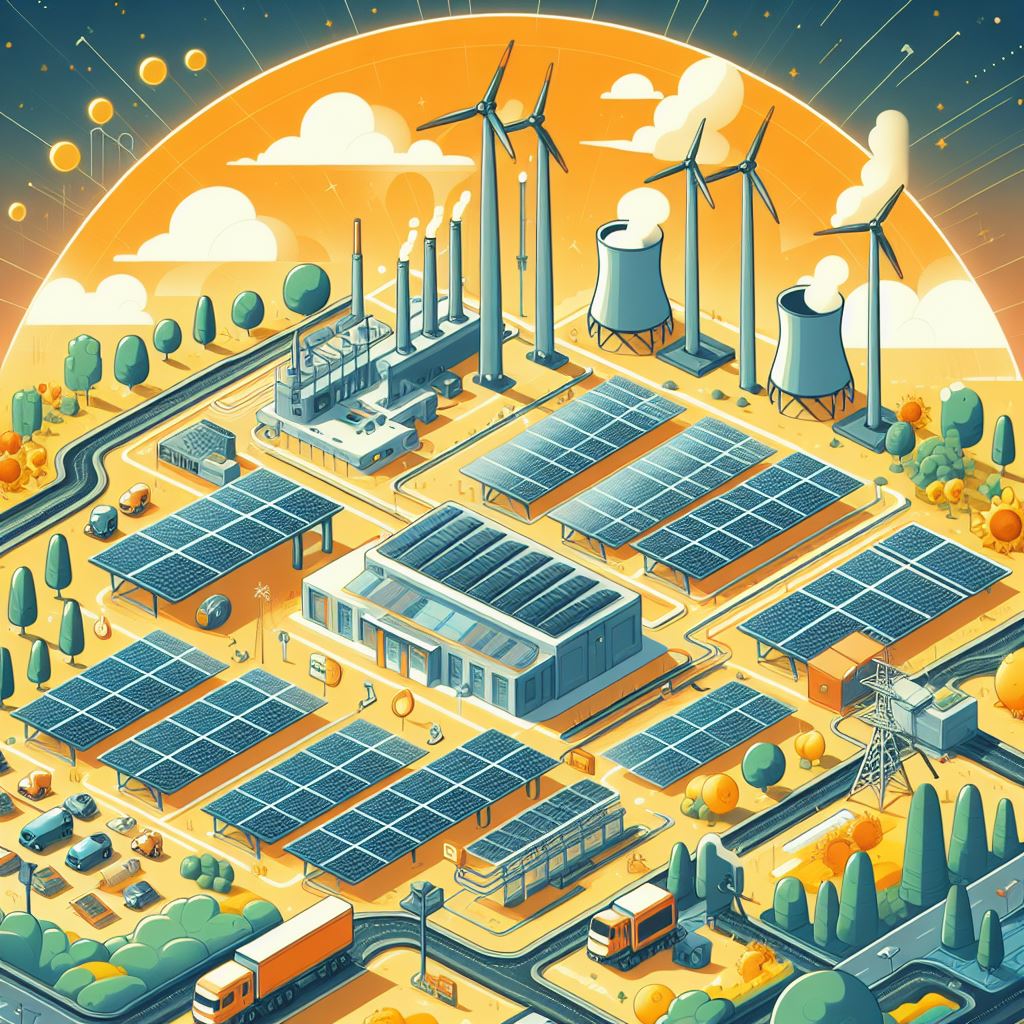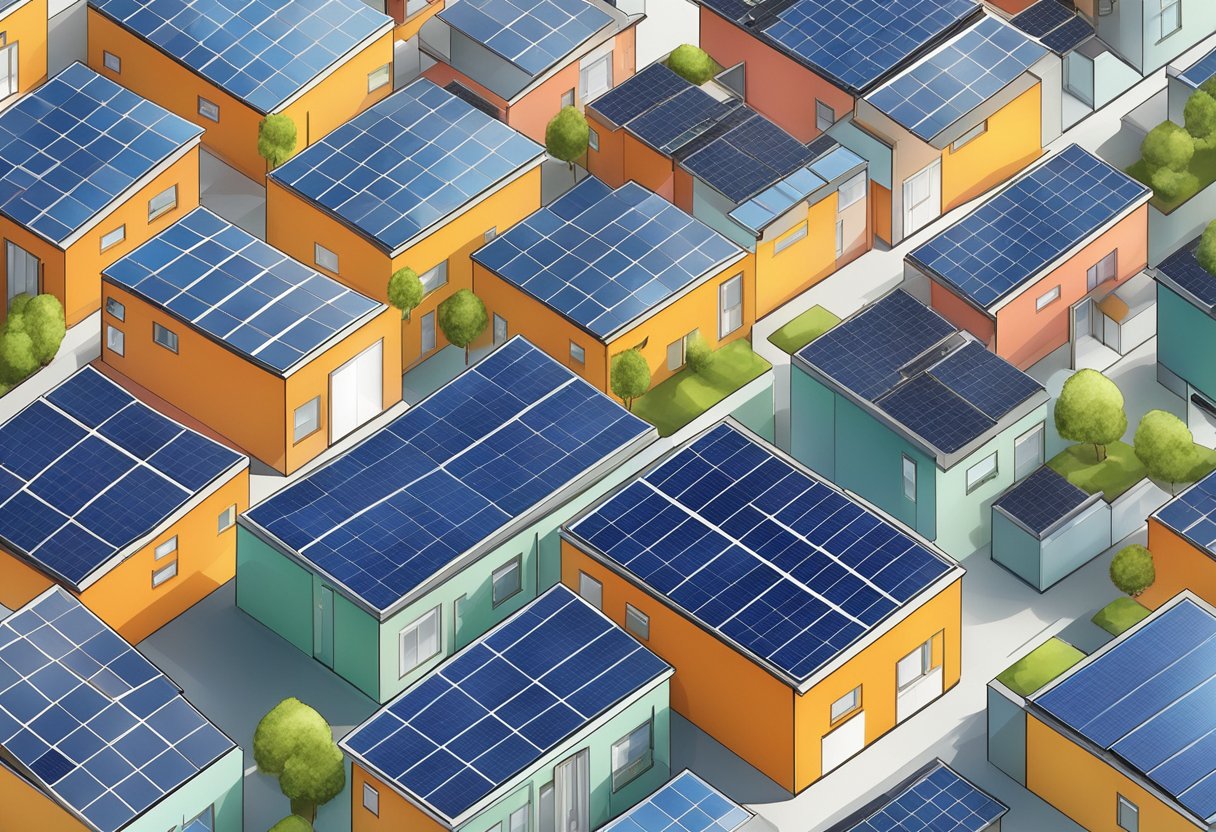Solar energy, as a concept, has been around for centuries. The ancient civilisations of Greece and Rome were aware of the power of the sun and used it to heat their homes and water. However, it wasn’t until the 19th century that significant advancements were made in harnessing solar energy.
In 1839, French physicist Edmond Becquerel discovered the photovoltaic effect, which is the process by which sunlight is converted into electricity. This discovery laid the foundation for the development of solar panels as we know them today.
The Rise of Photovoltaic Cells
The 20th century saw a rapid increase in the use of photovoltaic cells for generating electricity from sunlight. Bell Laboratories, in 1954, introduced the first commercially viable silicon solar cell. These cells were initially expensive and had a low efficiency, but over time, advancements in technology made them more affordable and efficient.
The oil crisis of the 1970s further fueled the development of solar energy technology. Governments and researchers worldwide realized the need to find alternative sources of energy, and solar power emerged as a promising solution.
The Impact of Concentrated Solar Power
In recent years, concentrated solar power (CSP) has gained significant attention in the field of solar energy technology. CSP uses mirrors or lenses to concentrate sunlight onto a small area, generating heat that is then used to produce electricity through a steam turbine or other heat transfer mechanisms.
CSP has the advantage of being able to store excess heat and generate electricity even when the sun is not shining. This makes it a reliable source of renewable energy, especially for large-scale applications.
The Emergence of Thin-Film Solar Panels
Thin-film solar panels have emerged as an alternative to traditional silicon-based solar panels. These panels are made by depositing thin layers of photovoltaic material onto a substrate, such as glass or metal. They are lightweight, flexible, and can be manufactured using less energy and resources compared to traditional solar panels.
Thin-film solar panels also have the potential to be integrated into various surfaces, such as windows, walls, and even clothing, allowing for more innovative and aesthetically pleasing solar energy solutions.
Increased Efficiency in Solar Panels
One of the main trends in solar energy technology is the continuous improvement in the efficiency of solar panels. Researchers and manufacturers are constantly working on developing new materials and technologies to enhance the conversion of sunlight into electricity.
Efficiency improvements not only lead to higher energy production but also reduce the overall cost of solar power systems. This makes solar energy more economically viable and attractive to both residential and commercial consumers.
Integration of Energy Storage Systems
Energy storage is a crucial aspect of solar energy technology. While solar panels generate electricity during the day, there is often excess energy that is not immediately consumed. Integrating energy storage systems, such as batteries, allows for the capture and storage of this excess energy for later use.
Advancements in battery technology have made energy storage more efficient, affordable, and environmentally friendly. This enables solar energy systems to provide a consistent and reliable supply of electricity, even during periods of low sunlight.
Advancements in Solar Tracking Systems
Solar tracking systems are designed to maximize the efficiency of solar panels by orienting them towards the sun throughout the day. Traditional fixed solar panels are stationary and can only capture sunlight at a specific angle, limiting their energy production potential.
However, with the advancements in solar tracking systems, panels can automatically adjust their position to follow the sun’s path, optimizing energy generation. This technology significantly improves the overall efficiency of solar energy systems, especially in areas with varying sunlight angles throughout the day.
The Role of Artificial Intelligence in Solar Energy
Artificial intelligence (AI) is playing an increasingly important role in optimizing the performance and efficiency of solar energy systems. AI algorithms can analyze data from sensors, weather forecasts, and historical energy consumption patterns to optimize the operation of solar panels and energy storage systems.
AI can predict and adjust the output of solar panels based on real-time weather conditions, ensuring maximum energy production. It can also optimize the charging and discharging cycles of battery systems, prolonging their lifespan and maximizing their efficiency.
Solar-Powered Transportation
Solar energy is not only being used to power homes and businesses but also to revolutionize transportation. Solar-powered vehicles, such as cars, boats, and even airplanes, are becoming increasingly popular as a sustainable alternative to traditional fossil fuel-powered vehicles.
Solar panels integrated into the exteriors of these vehicles capture sunlight and convert it into electricity, which is stored in batteries and used to power the vehicle’s motor. This reduces the reliance on fossil fuels and contributes to reducing greenhouse gas emissions.
Perovskite Solar Cells: The Next Big Thing?
Perovskite solar cells have emerged as a promising alternative to traditional silicon-based solar cells. These cells are made using a synthetic material called perovskite, which is cheaper and easier to produce compared to silicon.
Perovskite solar cells have the potential to achieve higher efficiencies and can be manufactured using low-cost printing techniques. Researchers are currently working on overcoming the challenges associated with their stability and durability to make them a commercially viable option in the future.
Solar-Powered Smart Homes
Smart home technology is becoming increasingly popular, and solar energy is playing a significant role in powering these advanced homes. Solar panels integrated into the roofs of smart homes can generate electricity, which can be used to power various devices and appliances within the home.
Additionally, smart home systems can optimize energy consumption based on real-time solar energy production, weather conditions, and energy storage levels. This ensures that energy is utilized efficiently, reducing overall energy consumption and costs.
Read More: How Solar Farms Work: Explaining Photovoltaic Power Stations
Solar-Powered Desalination Systems
Access to clean water is a global challenge, especially in arid regions. Solar-powered desalination systems offer a sustainable solution by using solar energy to remove salt and impurities from seawater or brackish water.
These systems use solar thermal or solar photovoltaic technology to power the desalination process, making it more energy-efficient and environmentally friendly compared to conventional desalination methods. Solar-powered desalination has the potential to provide clean drinking water to millions of people around the world.
Solar-Powered Wearable Technology

Wearable technology, such as fitness trackers and smartwatches, has become increasingly popular in recent years. Solar-powered wearable devices are being developed to eliminate the need for frequent charging or battery replacements.
These devices incorporate tiny solar panels that can generate electricity from ambient light, ensuring continuous operation without the need for external power sources. Solar-powered wearables not only provide convenience but also contribute to reducing electronic waste.
Space-Based Solar Power: Science Fiction or Reality?

Space-based solar power is a concept that involves capturing sunlight in space and transmitting it to Earth using satellites or other means. This technology has the potential to provide a virtually unlimited supply of clean energy, as solar panels in space can capture sunlight 24/7, without being affected by weather conditions or nightfall.
While the concept of space-based solar power is still in the experimental stage, researchers and scientists are exploring the feasibility and potential challenges associated with its implementation. If successful, space-based solar power could revolutionize the way we generate and consume energy on Earth.
Improving Solar Energy Storage
Energy storage is a critical aspect of solar energy technology, as it allows for the utilization of solar power even when the sun is not shining. While advancements in battery technology have significantly improved energy storage systems, there is still room for improvement.
Researchers are working on developing new materials and technologies that can enhance the energy storage capacity, efficiency, and lifespan of batteries. Additionally, alternative energy storage solutions, such as flow batteries and thermal storage systems, are being explored to overcome the limitations of traditional battery technologies.
Addressing the Issue of Intermittency
Solar energy is intermittent by nature, as it relies on sunlight availability. This intermittency poses challenges in meeting the constant demand for electricity. However, advancements in energy storage systems, as mentioned earlier, are helping address this issue.
Additionally, the integration of solar energy with other renewable energy sources, such as wind power or hydropower, can provide a more consistent and reliable supply of electricity. Smart grid technologies, which enable the efficient distribution and management of electricity, also play a crucial role in addressing the intermittency challenge.
Enhancing Solar Panel Durability and Longevity
Solar panels are exposed to various environmental factors, such as temperature fluctuations, humidity, and UV radiation, which can affect their performance and lifespan. Enhancing the durability and longevity of solar panels is essential to ensure their long-term effectiveness.
Researchers are working on developing protective coatings and materials that can withstand harsh environmental conditions, reducing the degradation of solar panels over time. Additionally, advancements in manufacturing processes and quality control measures are being implemented to ensure the production of high-quality and reliable solar panels.
Making Solar Energy More Accessible and Affordable

One of the key challenges in solar energy adoption is its initial cost. While the long-term benefits of solar energy are undeniable, the upfront investment required can be a barrier for many individuals and businesses.
To overcome this challenge, governments and organizations are implementing various financial incentives and subsidies to make solar energy more accessible and affordable. Additionally, innovative financing options, such as solar leasing and power purchase agreements, are being offered to reduce the financial burden on consumers.
Ensuring Sustainable Manufacturing Practices
The production of solar panels and other solar energy components requires the use of raw materials and energy, which can have an environmental impact. Ensuring sustainable manufacturing practices is crucial to minimize the ecological footprint of solar energy technology.
Manufacturers are increasingly adopting eco-friendly production processes, such as recycling and reducing waste generation. Additionally, the use of sustainable materials and responsible sourcing practices are being encouraged to promote the overall sustainability of solar energy technology.
The Potential of Solar Energy in Combating Climate Change
Solar energy has the potential to play a significant role in combating climate change. As a clean and renewable energy source, solar power produces zero greenhouse gas emissions during operation, unlike fossil fuels.
By transitioning to solar energy, we can reduce our reliance on fossil fuels and significantly decrease carbon dioxide emissions. This can help mitigate the effects of climate change, such as rising global temperatures, extreme weather events, and sea-level rise.
Solar Energy as a Key Player in the Transition to Renewable Energy
The transition to renewable energy is essential for a sustainable future, and solar energy is poised to be a key player in this transition. As technology advancements continue to improve the efficiency and affordability of solar power, it is becoming an increasingly attractive option for individuals, businesses, and governments.
Solar energy has the potential to replace a significant portion of our current energy consumption, reducing our dependence on finite fossil fuel resources. This transition to renewable energy sources, including solar power, is crucial to ensure a reliable and sustainable energy future.
The Role of Government and Policy in Driving Solar Energy Adoption

Government support and favorable policies play a crucial role in driving the adoption of solar energy. Many countries have implemented incentives, such as feed-in tariffs, tax credits, and grants, to encourage the installation of solar power systems.
Additionally, policies that promote net metering, which allows solar energy system owners to sell excess electricity back to the grid, further incentivize the adoption of solar energy. Governments also play a role in setting renewable energy targets and implementing regulations to accelerate the transition to solar power.
The Economic Benefits of Solar Energy
Solar energy not only provides environmental benefits but also offers significant economic advantages. The solar industry has become a major source of job creation, providing employment opportunities in manufacturing, installation, maintenance, and research and development.
Furthermore, investing in solar energy can lead to energy cost savings for consumers. By generating their own electricity, individuals and businesses can reduce their reliance on the grid and potentially lower their energy bills. This economic benefit, coupled with the long-term cost savings of solar energy, makes it an attractive option for both residential and commercial consumers.
Embracing Solar Energy: A Sustainable Choice for Individuals and Businesses

Embracing solar energy is not only a sustainable choice but also a smart investment for individuals and businesses. By harnessing the power of the sun, we can reduce our carbon footprint, contribute to a cleaner environment, and secure a more sustainable future.
Solar energy technology advancements have made it more accessible, affordable, and efficient than ever before. Whether it’s installing solar panels on rooftops, utilizing solar-powered appliances, or investing in solar-powered transportation, each individual and business has the power to make a positive impact and be part of the solar energy revolution.
In conclusion, the trends in solar energy technology advancements have come a long way since its humble beginnings. From the discovery of the photovoltaic effect to the emergence of innovative solar panel technologies, solar energy has evolved into a viable and sustainable solution for our energy needs. Current trends focus on increasing efficiency, integrating energy storage systems, advancing solar tracking systems, utilizing artificial intelligence, and exploring solar-powered transportation. Future innovations include perovskite solar cells, solar-powered smart homes, desalination systems, wearable technology, and space-based solar power. Overcoming challenges in solar energy technology involves improving storage, addressing intermittency, enhancing panel durability, making solar energy more accessible and affordable, and ensuring sustainable manufacturing practices. The future of solar energy lies in its potential to combat climate change, its role in the transition to renewable energy, government and policy support, economic benefits, and the sustainable choice it offers to individuals and businesses. Embracing solar energy is not only a wise decision but also a step towards a cleaner and brighter future.















